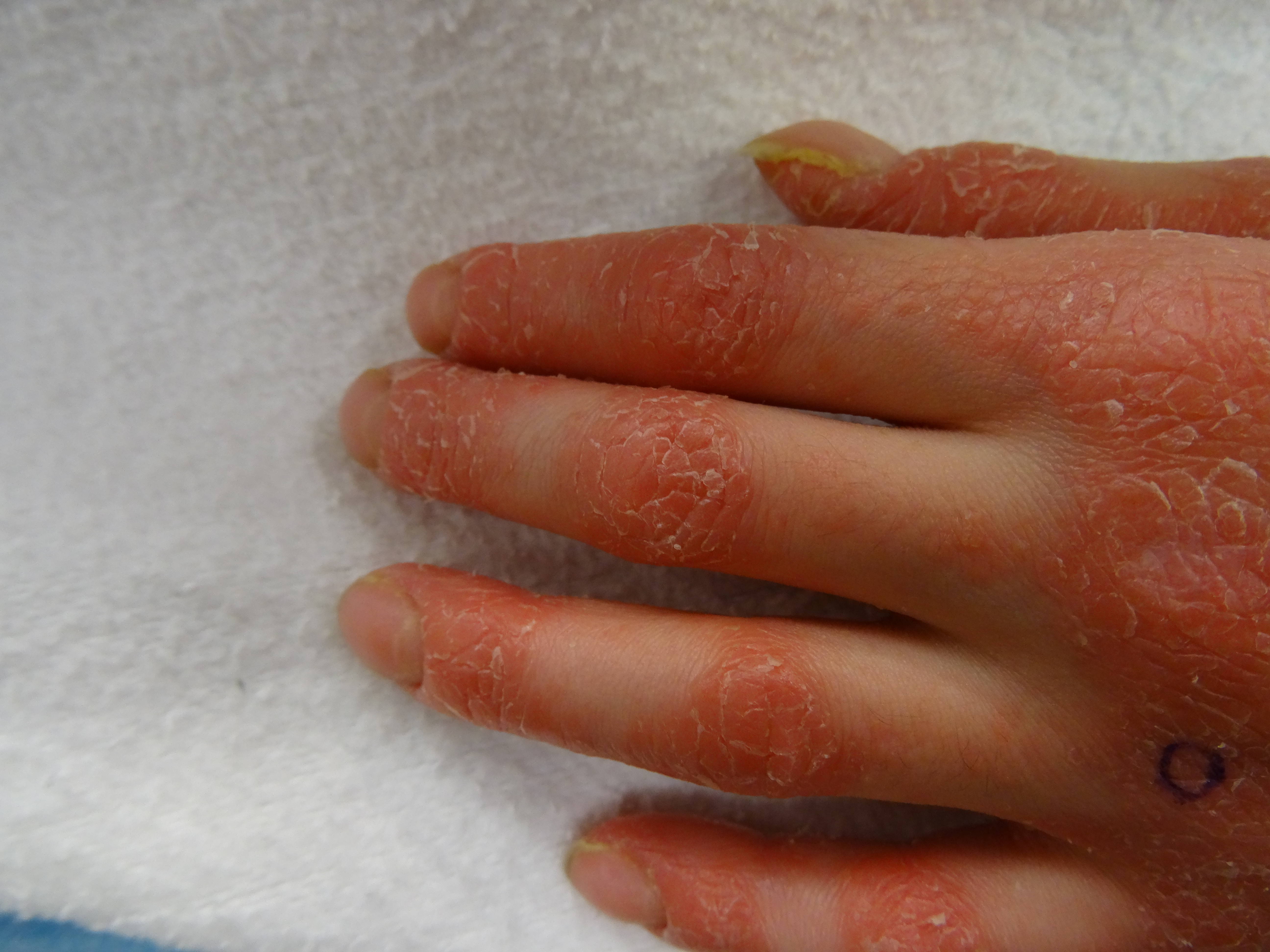(dermatopolymyositis, polymyositis)
Estimated prevalence : 1/15,000 adults over 50 years of age : women are twice more frequently affected than men. Chronic inflammation of the connective tissue that affects certain areas of the skin (in general uncovered areas with photosensitivity) and some skeletal muscles, as well as a small vessel vasculitis. The term juvenile form (incidence: 2/106) is used when the disease starts between 5 and 14 years of age: this form, if diagnosed and treated early, has a better prognosis than the adult form. However, it can cause serious complications such as a pneumothorax (bubbles), a pneumomediastinum and hypoxic-ischemic-like neurological lesions or hypertensive encephalopathy when on high dose corticosteroid therapy.
Dermatomyositis causes:
- a purple (lilac) macular erythema on the upper eyelids ("heliotrope") or periorbital area,
- a purple erythema on the extension face of the fingers and around the fingernails
- myalgias with variable, usually proximal and symmetrical, muscular weakness
- fever with altered general status
- the presence of Gottron’s papules (30 %): red, often scaly, bumps overlying the knuckles of the fingers
- if the oropharyngeal muscles are affected: dysphagia, voice changes, aspiration
- if the respiratory muscles are affected: dyspnea or respiratory failure. the involvement of the diaphragm is often paucisymptomatic or underestimated but it reduces the effectiveness of cough
- the juvenile form is distinguished by the presence of a calcinosis (hard to the touch bumps under the skin, or sometimes in muscles), and sometimes a lipodystrophy
Sometimes:
- arrhythmias: due to myocarditis or pericarditis
- a Raynaud’s syndrome (10-15 %)
- lung disease: either aspiration pneumonia in case of pharyngeal muscles involvement (15-20 %) or diffuse interstitial disease (more frequent in case of anti-synthetase syndrome, see this term); severe pulmonary hypertension may appear
- biliary cirrhosis
- extension to the scalp: reddish and crusted plates with pruritus.
The diagnosis is made on the basis of the clinical picture, presence of very high CPK and LDH levels and muscle biopsy or MRI.
The clinical distinction between amyopathic dermatomyositis , dermatopolymyositis, and polymyositis depends on the presence or absence of skin and muscles involvement. From a pathological point of view, it seems that dermatomyositis is the result of a malfunction of the humoral immunity whereas polymyositis could rather be the result of dysfunction of cellular immunity.
Dermatomyositis may be associated with scleroderma, lupus erythematosus or Sjögren syndrome. In adults, it is sometimes a paraneoplastic syndrome: cancer of the breast, ovary, lung, colon.
A rare and special form of dermatomyositis is the Wong syndrome which combines typical lesions of dermatomyositis and areas of psoriasiform cutaneous hyperplasia with parakeratosis in horizontal and vertical bands, follicular papules and palmoplantar keratoderma (pityriasis rubra pilaris) [MIM 173 200 for the familial form due to a mutation in the gene CARD14 on 17q25)].
Treatment: high-dose corticosteroids, sometimes immunosuppression or plasmapheresis.
Anesthetic implications:
- check blood count and CPK levels, ECG and echocardiography, respiratory function (+ X-ray or chest CT),
- side-effects of treatment and corticosteroid replacement therapy;
- skin fragility (plasters !).
- monitoring of curarization: variable sensitivity to non-depolarizing muscle rexants: reduced muscle mass, inflammation; slower onset of action of rocuronium and sugammadex in one case
- in cases of acute myositis (elevated CPK), succinylcholine should be avoided.
- risk of aspiration (dysphagia)
- risk of difficult intubation: reduced mouth opening, contractures

References :
- Tillie-Leblond I, Colin G, Lelong J, Cadranel J.
Atteintes pulmonaires des polymyosites et dermatomyosites.
Rev Mal Respir 2006 ; 23 : 671-80.
- Elst EF, Kamphuis SSM, Prakken BJ.
Severe central nervous system involvement in Juvenile Dermatomyositis.
J Rheumatol 2003 ; 30 : 2059-63.
- Masaaki S, Bando T, Hasegawa S et al.
Recurrent spontaneous pneumothoraces associated with juvenile polymyositis.
Chest 2000; 118: 1509-11.
- Haro R, Revelles JM, del carmen Farina M, Martin L, Requena L.
Wong’s dermatomyositis: a new case and review of the literature.
Int J Dermatol 2013; 52: 466-70.
- Suzuki T, Nameki K, Shimizu H, Shimizu Y, Nakamura R, Ogawa S.
Efficacy of rocuronium and sugammadex in a patient with dermatomyositis.
Br J Anaesth 2012 ; 78 :703
- Parameswari A, Kanishka S, Kalaimani K, et al.
Anesthetic challenges in laparoscopic surgery for a child with Juvenile Dermatomyositis.
Cureus 2024 ; 16(10): e71056. DOI 10.7759/cureus.71056
Updated: November 2024